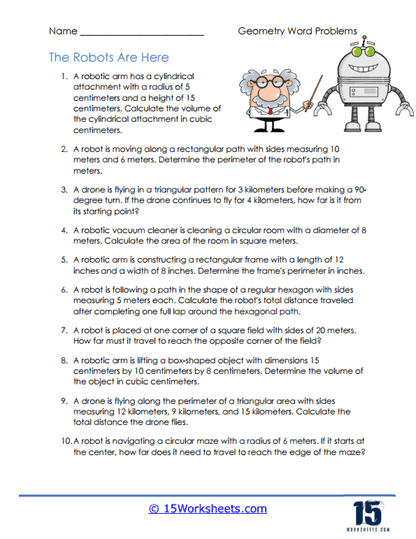The Robots Are Here

Worksheet Description
This worksheet is themed around robots and includes a variety of geometry word problems. Students must solve problems involving robotic arms with cylindrical attachments, robots moving along paths, drones flying in patterns, and robotic vacuum cleaners operating in rooms. Each problem requires the calculation of geometric properties such as volume, perimeter, and area, using the context of robotics to make the problems more engaging.
The worksheet teaches students to apply geometric formulas to calculate the area of rectangles and circles, the volume of cylinders, and the perimeter of various shapes in the context of modern robotics. It also aims to strengthen problem-solving skills by having students convert practical situations into mathematical equations. By using robots, which are commonly associated with technology and innovation, the worksheet seeks to make the study of geometry more interesting and relevant to the students. This approach not only solidifies the students’ understanding of geometry but also connects it to contemporary applications.
Example Problems
1. A robotic arm has a cylindrical attachment with a radius of 5 centimeters and a height of 15 centimeters. Calculate the volume of the cylindrical attachment in cubic centimeters.
2. A robot is moving along a rectangular path with sides measuring 10 meters and 6 meters. Determine the perimeter of the robot’s path in meters.
3. A drone is flying in a triangular pattern for 3 kilometers before making a 90-degree turn. If the drone continues to fly for 4 kilometers, how far is it from its starting point?
4. A robotic vacuum cleaner is cleaning a circular room with a diameter of 8 meters. Calculate the area of the room in square meters.
5. A robotic arm is constructing a rectangular frame with a length of 12 inches and a width of 8 inches. Determine the frame’s perimeter in inches.
6. A robot is following a path in the shape of a regular hexagon with sides measuring 5 meters each. Calculate the robot’s total distance traveled after completing one full lap around the hexagonal path.
7. A robot is placed at one corner of a square field with sides of 20 meters. How far must it travel to reach the opposite corner of the field?
